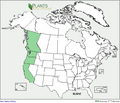Difference between revisions of "Allium amplectens"
m (Tag: VisualEditor) |
|||
| Line 1: | Line 1: | ||
| + | * Latin Name: ''Allium'' ''amplectens'' | ||
| + | * Family: Amaryllidaceae | ||
| + | * Common Names: narrow-leaf onion | ||
| + | * Synonyms/Misapplications: ''Allium'' ''acuminatum, Allium'' ''attenuifolium, Allium'' ''monospermum, Allium'' ''occidentale, Allium'' ''serratum'' | ||
| + | * Codon: ALLAMP | ||
{{Taxobox | {{Taxobox | ||
| name = Allium amplectens|image= Allium amplectens Pinnacles2.jpg | | name = Allium amplectens|image= Allium amplectens Pinnacles2.jpg | ||
| Line 24: | Line 29: | ||
| − | |||
| − | |||
| − | |||
| Line 32: | Line 34: | ||
===Description=== | ===Description=== | ||
| − | Perennial growing from sometimes clustered and ovoid bulbs. Stem somewhat cylindrical, 15-50 cm tall. 2-4 slender leaves growing from the scape that wither early. Almost spherical multi-flowered white or pink umbels. Tepals 6; pedicals slender 1-2 times length of tepals. Stamens 6 and as long as the tepals. Tepals become papery and converge over fruit with maturity, the fruit 3-celled and 6-seeded.<ref name="UW"/> | + | Perennial growing from sometimes clustered and ovoid bulbs. Stem somewhat cylindrical, 15-50 cm tall. 2-4 slender leaves growing from the scape that wither early. Almost spherical multi-flowered white or pink umbels. Tepals 6; pedicals slender 1-2 times length of tepals. Stamens 6 and as long as the tepals. Tepals become papery and converge over fruit with maturity, the fruit 3-celled and 6-seeded.<ref name="UW" /> |
<ref name="Jepson">[http://ucjeps.berkeley.edu/cgi-bin/get_JM_treatment.pl?8349,8354,8357 Jepson Flora Project]</ref> | <ref name="Jepson">[http://ucjeps.berkeley.edu/cgi-bin/get_JM_treatment.pl?8349,8354,8357 Jepson Flora Project]</ref> | ||
| Line 42: | Line 44: | ||
California, Oregon, Washington, and British Columbia. | California, Oregon, Washington, and British Columbia. | ||
===Habitat=== | ===Habitat=== | ||
| − | Open or wooded areas with clay soils <ref name="Jepson"/> | + | Open or wooded areas with clay soils <ref name="Jepson" /> |
===Uses=== | ===Uses=== | ||
| Line 73: | Line 75: | ||
[[File:Allium amplectens.jpg|300px|thumb|left|''Allium amplectens'']] | [[File:Allium amplectens.jpg|300px|thumb|left|''Allium amplectens'']] | ||
[[File:Allium amplectens single.jpg|300px|thumb|right|''Allium amplectens'']] | [[File:Allium amplectens single.jpg|300px|thumb|right|''Allium amplectens'']] | ||
| − | |||
| Line 88: | Line 89: | ||
===References=== | ===References=== | ||
| − | < | + | <references /> |
Revision as of 19:26, 2 June 2020
- Latin Name: Allium amplectens
- Family: Amaryllidaceae
- Common Names: narrow-leaf onion
- Synonyms/Misapplications: Allium acuminatum, Allium attenuifolium, Allium monospermum, Allium occidentale, Allium serratum
- Codon: ALLAMP
| Allium amplectens | |
|---|---|

| |
| Allium amplectens | |
| Scientific classification | |
| Kingdom: | Plantae |
| Subkingdom: | Tracheobionta |
| Phylum: | Spermatophyta |
| Subphylum: | Magnoliophyta |
| Class: | Liliopsida – Monocotyledons |
| Subclass: | Liliidae |
| Order: | Liliales |
| Family: | Liliaceae |
| Genus: | Allium L. |
| Species: | Allium amplectens Hook. |
| Synonyms | |
| |
Contents
Description
Perennial growing from sometimes clustered and ovoid bulbs. Stem somewhat cylindrical, 15-50 cm tall. 2-4 slender leaves growing from the scape that wither early. Almost spherical multi-flowered white or pink umbels. Tepals 6; pedicals slender 1-2 times length of tepals. Stamens 6 and as long as the tepals. Tepals become papery and converge over fruit with maturity, the fruit 3-celled and 6-seeded.[1] [2]
Bloom Period
May-July [1]
Distribution
California, Oregon, Washington, and British Columbia.
Habitat
Open or wooded areas with clay soils [2]
Uses
The bulbs were occasionally eaten by some northwest coast indigenous peoples. *This is a restricted species; please do not harvest.
Propagation
http://www.goert.ca/propagation_guidelines/forbs/allium_amplectens
Seed
Seed sample from: 2011
Average Measurement: 2.1 x 1.7 x 1.7
Measurement Range: L: 1.8 - 2.5, W: 1.5 - 1.8, D: 1.3 - 1.75
Features
Shape: Seeds narrow at hilum end, broadening at opposite apex.
Color: Seeds black. Hilum beige to white.
Surface: Seed’s most distinct feature is extreme puckering or wrinkling. Some seeds have concave pitting, ridging, or some net veined patterns. Seeds roughly textured and matte.
Latitudinal Cross Section: elliptical ![]()
Longitudinal Cross Section: elliptical ![]()
Basic Explanations and Assumptions:
The dimensions for the seeds are length x width x depth. The location of the hilum is used as the base of the seed, and the length is measured from hilum to the opposite apex. Where a style is present, the length is measured from the hilum to the bottom of the style. Width is measured at a right angle to the length at the widest part. Depth is measured at a right angle to the intersection of height and width lines.
Measurements included are the mean average for each measurement of ten separate seeds.
All measurements in millimeters unless otherwise noted.







